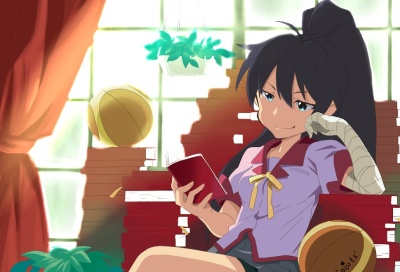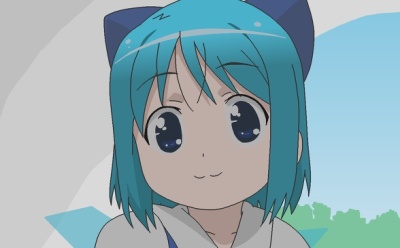When I took “The iDolM@ster 2″ for the PS3 for a spin over the weekend, much of the game’s aesthetics deviated little from the same arcade feel. The iconic “Project iM@S” logo looks like a page taken out of some failed bemani game pitch. Much of the gameplay is also full of rhythm and beats, leaving no room to complain about that mismatch. But in my mind the game has nothing on what really is, to me, the essence of the franchise.
Of course, that isn’t how the story begin. My first run-in with iM@S (for the sake of sanity it will remain in its insanely abbreviated form in this post) probably has more to do with being born a male East Asian during the time in this world that I did. Although it is a stretch to call that an encounter with iM@S, I think it was fundamental in the makeup of what makes up the average “Producer-san,” the anonymous term in which the various in-game characters refer to as the player.
I think the only other game to date that walked (or perhaps trailblazed) the same path as Project iM@S is Sakura Taisen, and that is one blueprint in which a video games achieve mix-media franchising immortality. It’s one thing to create a game that goes on being immortal (and we can name a dozen of these easily), it’s another to create a game like a caterpillar creates a cocoon. The game may fade over time and yield to newer, glitzier ideas, but the franchise lives on with a dim, but ever-burning core fan base that participates in its extra-curricular activities. It’s just in the case of Sakura Taisen, the cocoon hatches a zombie butterfly of some sort; undying, but not immune to decay.
And like butterflies they were in those kayou shows, those brave actors and actresses, some even came to the stage as experienced stage actors. But yes, some others were, well, the seiyuu idol variety. They had to sing and dance, and act. It was interesting in that they were not only acting out the characters from the show, but also as actors of their own stage personalities.
Back to iM@S–it is entering its 8th year since the very first game. The recent PS3 port and the anime adaptation are sure to bring in new fans for the franchise, or at least get people curious enough to check out the game, like myself. I’m slightly more interested initially at the iM@S live shows, as the cumulation of sentimental energies and collective moments of orgasm from a bunch of male otaku types. And also, seiyuu fandom. I think someone reported like >90% male-to-female ratio at those lives? Not surprised.
The point I wanted to make about stage personalities is important because invariably this girl walks on the stage, and I was like, “heh, I don’t even have to remind myself of this video being Azusa.” I mean, some people commented on how her character in the anime is acted by the same person as in that video, but there is nothing holding you back from seeing it when it is the actual person on stage.
Oh, right, the stage shows: It was “The World Is All One” two-day live July 3rd to 4th, 2010, at Makahari Messe. Day 2 is what I linked above to Danie’s write-up, a solid read if you want to know what actually happened. Day two is also the day to go if you are a Kugimiya fan. In fact both days are good for that. There are a lot of people who really dig this gal, so I’m not going to talk about it too much, besides that I watched that two-BD boxset and now am ready to talk about it.
 It is at these sort of fantasy-meets-reality events where we truly get to see the meta. If I were to rank the 13 girls again like how I did for the anime, it would come out very differently. Even more so is the “cumulative” score that true fans of the franchise put on their ranks, combining what they like and dislike about each character, from who stands behind the mic stand in real life and who stands behind the protective layer of their LCD screens, and everything in between.
It is at these sort of fantasy-meets-reality events where we truly get to see the meta. If I were to rank the 13 girls again like how I did for the anime, it would come out very differently. Even more so is the “cumulative” score that true fans of the franchise put on their ranks, combining what they like and dislike about each character, from who stands behind the mic stand in real life and who stands behind the protective layer of their LCD screens, and everything in between.
Well, at least now I can achieve an 80% success rate at identifying the faces of the girls behind iM@S. Which is to say before the anime started, I was probably not even 80% successful at identifying the characters in iM@S. In the few hours I’ve spent with the game, I guess it actually tried to train me to be able to listen to their voices and pick them out. That’s pretty hardcore. All told, there’s a considerable learning curve, lack of a better term, to entry to iM@S fandom. The thing has been around for a while and the games are, while a little easier to get into than Sakura Taisen, are not exactly self-documenting. Sorry Kotori, the voiceovers are not quite enough. There’s just too much crud, as part and beyond the franchise, to wade through at this point.
Instead of writing up what I thought of the two days in a song-by-song blow-by-blow way, I’ll just keep it short(er):
- Hibiki – Sharp-looking girl doing her dance moves. Got good presence. Can sing. A winner.
- Ritsuko – Slightly less sharp-looking girl making all those fetish points work but not fetishy! As much as one can harp on her singing voice, I think she is the best embodiment of this weird iM@S concert concept.
- Miki – Not the bombshell blonde, this Miki carries it on with the full deal. It felt like she’s got what it takes, but yet not what it takes, to do Miki justice. It’s realizations like this that makes this feel like an elaborate seiyuu event rather than an idol live.
- Azusa – CHUPA RIKO wwww. No, really, Chiaking is an accomplished entertainer even if her achievements are relatively minor. She can dance and sing and struct, which is more than what most people sharing a stage with her could do. Mucho respect.
- Chihaya – I think she sings much better on CD. Also what is up with her hair? They can surely do a better job. BTW I really like LPCM 5.1 and this is something the game was able to deliver too.
- Makoto – She’s definitely the most seiyuu-ish looking person on the list, if that made sense. But that’s fine, I think Hirorin is also one of the best performers with good stage presence. Kind of like Hasegawa in that sense.
- Iori – I owe her fans an apology for not ranking her last time, but I was limited to 12 and it had to include Ami separately from Mami. I think Kugyuu live was definitely well-received and she appears so…langly. It’s rare to see a girl in this industry like this unless they’re built like a model (which she is not). It was wise for them to not work her as much as they did for some others, and we never really ask so much from Iori anyway. She just needed to be cute and upstanding, and Kugimiya was just that.
- Haruka – Eririn is actually just as unremarkable as her character. However, she is still pretty good at getting the crowd going and had good stage presence.
- Mami/Ami – If I wasn’t already positively predisposed to Asapon, I would probably rank her lower than Maya-chan. She didn’t quite pass the cute as cute would do, but her vocals were solid.
- Takane – It feels like her character is just an overly-embellished version of her on-stage performance. Pretty looking person I suppose.
- Yayoi – Guh. Actually out of all the girls I think I respect her the most. You can also tell how none of this is lipsynched given how terrible it was. It was sheer and paper-thin presence that managed to carry the performance. It’s like magic made of unrelenting willpower to carry out an act that just didn’t make sense visually. Again, endless respect–Maya-chan impressed, even if the performance was one of the worst.
- Kotori – I was glad she was there, but I guess so was she!
- Yukiho – I put her last but I think that is more because she was the least notable. The NEW Yukiho is a bit more of a looker though. Well, I won’t go into details, but someone has to hold the bag, be #12, and it was just the easiest thing to put her there.
I guess in the end I still didn’t really describe the magnitude of that 2-day live. It’s a big deal if you were into it, and I don’t mean into iM@S alone–it is more like if you subscribed to iM@S you probably subscribed to all the things that independently iM@S’s live had as separate parts. It became greater than the sum of its parts, but the sum itself was a big deal already. It’s like you had to be born a certain way and grew up a certain way and got exposed to certain interests, and it comes together like some crazy thing.
But then again, I guess even I too missed the train there.
What is left is trying to know all the songs, and that is a task too tall even for me, lest I get serious. But I just want a short fling with iM@S! I don’t want to turn into this guy (I jest). Even if some of those songs have the cutest/catchiest/funniest calls.




